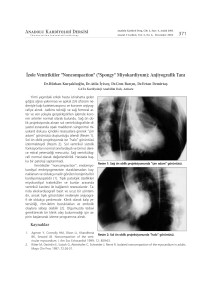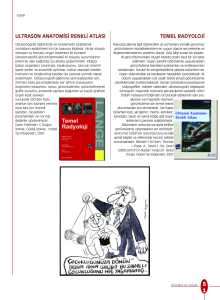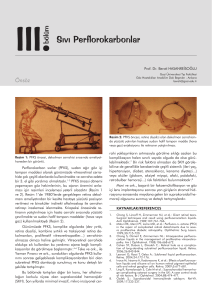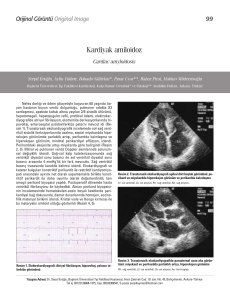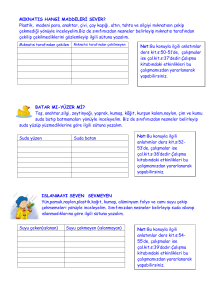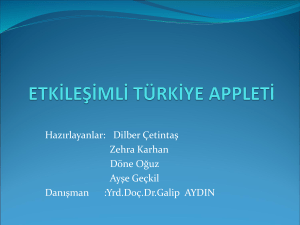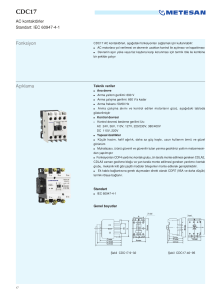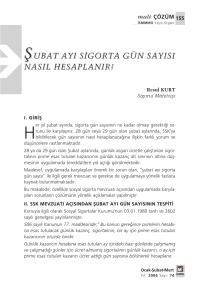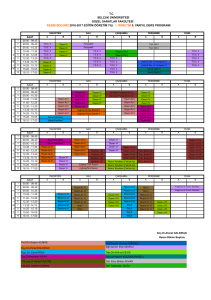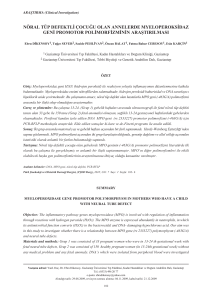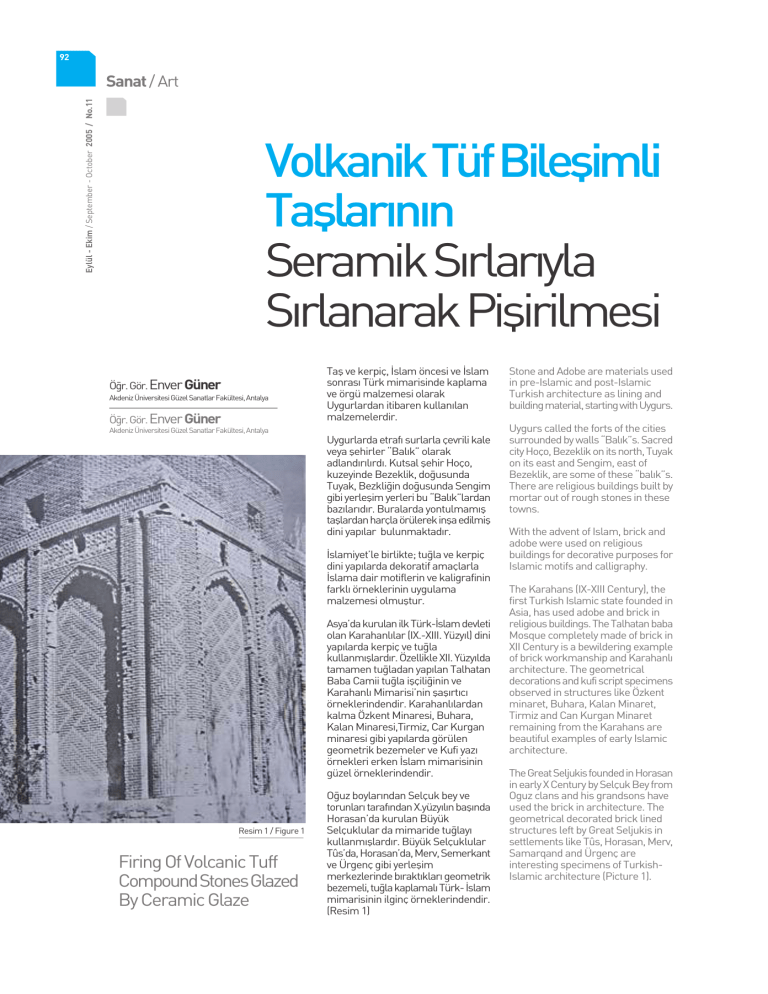
92
Eylül - Ekim / September - October 2005 / No.11
Sanat / Art
Volkanik Tüf Bileflimli
Tafllar›n›n
Seramik S›rlar›yla
S›rlanarak Piflirilmesi
Ö¤r. Gör. Enver Güner
Akdeniz Üniversitesi Güzel Sanatlar Fakültesi, Antalya
Ö¤r. Gör. Enver Güner
Akdeniz Üniversitesi Güzel Sanatlar Fakültesi, Antalya
Tafl ve kerpiç, ‹slam öncesi ve ‹slam
sonras› Türk mimarisinde kaplama
ve örgü malzemesi olarak
Uygurlardan itibaren kullan›lan
malzemelerdir.
Uygurlarda etraf› surlarla çevrili kale
veya flehirler “Bal›k” olarak
adland›r›l›rd›. Kutsal flehir Hoço,
kuzeyinde Bezeklik, do¤usunda
Tuyak, Bezkli¤in do¤usunda Sengim
gibi yerleflim yerleri bu “Bal›k”lardan
baz›lar›d›r. Buralarda yontulmam›fl
tafllardan harçla örülerek infla edilmifl
dini yap›lar bulunmaktad›r.
‹slamiyet’le birlikte; tu¤la ve kerpiç
dini yap›larda dekoratif amaçlarla
‹slama dair motiflerin ve kaligrafinin
farkl› örneklerinin uygulama
malzemesi olmufltur.
Asya’da kurulan ilk Türk-‹slam devleti
olan Karahanl›lar (IX.-XIII. Yüzy›l) dini
yap›larda kerpiç ve tu¤la
kullanm›fllard›r. Özellikle XII. Yüzy›lda
tamamen tu¤ladan yap›lan Talhatan
Baba Camii tu¤la iflçili¤inin ve
Karahanl› Mimarisi’nin flafl›rt›c›
örneklerindendir. Karahanl›lardan
kalma Özkent Minaresi, Buhara,
Kalan Minaresi,Tirmiz, Car Kurgan
minaresi gibi yap›larda görülen
geometrik bezemeler ve Kufi yaz›
örnekleri erken ‹slam mimarisinin
güzel örneklerindendir.
Resim 1 / Figure 1
Firing Of Volcanic Tuff
Compound Stones Glazed
By Ceramic Glaze
O¤uz boylar›ndan Selçuk bey ve
torunlar› taraf›ndan X.yüzy›l›n bafl›nda
Horasan’da kurulan Büyük
Selçuklular da mimaride tu¤lay›
kullanm›fllard›r. Büyük Selçuklular
Tûs’da, Horasan’da, Merv, Semerkant
ve Ürgenç gibi yerleflim
merkezlerinde b›rakt›klar› geometrik
bezemeli, tu¤la kaplamal› Türk- ‹slam
mimarisinin ilginç örneklerindendir.
(Resim 1)
Stone and Adobe are materials used
in pre-Islamic and post-Islamic
Turkish architecture as lining and
building material, starting with Uygurs.
Uygurs called the forts of the cities
surrounded by walls “Bal›k”s. Sacred
city Hoço, Bezeklik on its north, Tuyak
on its east and Sengim, east of
Bezeklik, are some of these “bal›k”s.
There are religious buildings built by
mortar out of rough stones in these
towns.
With the advent of Islam, brick and
adobe were used on religious
buildings for decorative purposes for
Islamic motifs and calligraphy.
The Karahans (IX-XIII Century), the
first Turkish Islamic state founded in
Asia, has used adobe and brick in
religious buildings. The Talhatan baba
Mosque completely made of brick in
XII Century is a bewildering example
of brick workmanship and Karahanl›
architecture. The geometrical
decorations and kufi script specimens
observed in structures like Özkent
minaret, Buhara, Kalan Minaret,
Tirmiz and Can Kurgan Minaret
remaining from the Karahans are
beautiful examples of early Islamic
architecture.
The Great Seljukis founded in Horasan
in early X Century by Selçuk Bey from
Oguz clans and his grandsons have
used the brick in architecture. The
geometrical decorated brick lined
structures left by Great Seljukis in
settlements like Tûs, Horasan, Merv,
Samarqand and Ürgenç are
interesting specimens of TurkishIslamic architecture (Picture 1).
93
Semerkant, Kad›zadei Rumî
Türbesi Çini mozaik ve s›rl›
tu¤lan›n kullan›ld›¤› ilk
örneklerdendir.
Kad›zadei Rumî Tomb in
Samarqand is an early specimen
where tile mosaic and glazed brick
was used.
Daha sonra tarihsel süreç
içerisinde Anadolu Selçuklular›,
Anadolu’nun de¤iflik yerlerinde
yapt›klar› saraylarda, camilerde,
medrese ve külliyelerde tu¤la, s›rl›
tu¤la, çini, çini mozaik, kesme tafl,
renkli tafl ve mermeri mimarinin
farkl› yap›lar›nda kullanmaya
devam etmifltir. (Resim 2,3)
Later; brick, glazed brick, tile, tile
mosaic, cut stone, colored stone
and marble continued to be used
in different structures of
architecture like palaces, mosques,
madrassahs and complexes built
by Anatolian Seljukis in different
parts of Anatolia, along history.
(Picture 2,3)
S›rl› tu¤la ‹slam mimarisinin süsleme unsuru
olarak Osmanl›n›n ilk dönemlerinde kullan›lm›flt›r.
(‹znik Yeflil Camii) Hatta birinci ulusal mimarl›k
dönemi mimarlar›ndan Mimar Kemalettin ve
Mimar Vedat Tek beylerde eserlerinde
kullanm›fllard›r.
Tafl, s›rl› tu¤la ve çini geleneksel mimaride
yüzy›llard›r kullan›lan malzemelerdir. Ancak bu
çal›flmayla “S›rl› Tafl” kavram›yla ilk defa
karfl›laflmaktay›z.
Orta Anadolu’da Kayseri ve Nevflehir yörelerinde
bulunan Kayseri ‹-19 1/100.000’lik (Harita 1)
paftalar›nda yayg›n olarak görülen bu kayaçlar
volkanik tüf olarak adland›r›lmaktad›r. Günümüzde
bu kayaçlarda çeflitli ocaklar aç›lm›fl modern ve
güncel tekniklerle iflletilmekte ve sat›lmaktad›r.
Ç›kar›lan bu tafllar bulunduklar› ocaklar›n adlar›
ile an›lmakta ve s›n›fland›r›lmaktad›r. Yayg›n olarak
faaliyet gösteren ve bilinen bu ocaklar ‹ncesu
Pembe, Aksalur Gülkurusu, Demirtafl Siyah,
Bafldere Firuzedir.
Glazed brick was used in the early periods of the
Ottomans as a decorative element of Islamic
architecture (Iznik Green Mosque). In fact, Mimar
Kemalettin and Mimar Vedat Tek, Architects of the
first national architecture, period have used it in
their works.
Resim 2: Keykavus’
fiifahanesi, Çini Mozaik
Picture 2: Keykavus
fiifahane, Tile Mosaic
Resim 3:
Köfle sütun bafll›¤›
Picture 3:
Corner column head
Harita 1
Map 1
Stone, Glazed Brick and Tile are materials used
for centuries in traditional architecture. However,
we meet the concept of “Glazed Stone” for the first
time in this study.
These rock formations found prevalently in Kayseri
‹-19 1/100.000 (Map 1) maps found in Kayseri and
Nevflehir regions of Central Anatolia are called
volcanic tuff. Various quaries have been opened in
these rock formations which are processed and
sold by modern and current techniques. These
extracted stones are known and classified by the
names of the quaries they come from. These
quaries operating in widespread form are ‹ncesu
Pembe, Aksalur Gülkurusu, Demirtafl Siyah and
Bafldere Firuze.
94
Eylül - Ekim / September - October 2005 / No.11
Sanat / Art
Volkanik tüfler kendi içerisinde Güllüda¤ Tüfü, Melendiz
Tüfü ve Alacaflar Tüfü olarak üç farkl› gruba ayr›lmaktad›r
ve yayg›n görülen tüf çeflitleri kristal ve litik tüftür. Bu
tüflerden al›nan 6 adet kayaç örne¤inden ince kesit
çal›flmalar› yap›lm›flt›r. Yap›lan bu ince kesit incelemeleri
sonucunda bölgedeki farkl› ocaklardan al›nan cams› kül
tüflerin hepsinde ortak mineral olarak plajiyoklaz (feldispat)
mineralleri ve tamamen volkan cam›ndan oluflan ve
volkanik kayaçlar›n hamur k›sm›n› oluflturan süngertafl›pümis görülmektedir (fiekil 1,2,3,4)
Volcanic tuffs fall under three different groups among
themselves as Güllüda¤ Tuff, Melendiz Tuff ve Alacaflar
Tuff, with the most prevalent ones being crystal and lythic
tuffs. Fine cross-sections were made on 6 rock specimens
taken from these tuffs. As a result of these fine crosssection analyses, in almost all glassy ash tuffs taken from
various quaries in the region; feldspar minerals are found
as common mineral and sponge stone-pumice made of
totally volcanic glass, forming the paste section of volcanic
rock formations (Figure 1, 2, 3, 4).
fiekil 1 / Figure 1
fiekil 2 / Figure 2
fiekil 3 / Figure 3
fiekil 4 / Figure 4
Polarizan Mikroskop alt›nda ‹nce kesit görüntüleri / Fine cross-section images under Polarizing Microscope
Bafldere civar›nda al›nan örneklerde ise farkl› olarak ana
bileflen olarak ojit ve tali bileflenler olarak ise zirkon ve
apatit mineralleri gözlenmifltir.
In specimens taken from Bafldere vicinity, ojite was found
as main component and zircon and apathite minerals
were observed as secondary components.
Çal›flman›n as›l konusunu oluflturan piflirme (1000ºC) ve
s›rlama ifllemleri bölgeden al›nan 6 adet örnek üzerinde
denenmifltir. Piflirilen örneklerin ince kesitte incelenmeleri
sonucunda çeflitli fakl›l›klar›n ortaya ç›kt›¤› görülmüfltür.
Özellikle bu iflleme tabi tutulan örnekleri oluflturan ojit ve
hornblend minerallerinin etraf›nda opasitleflme türü
alterasyonlar›n meydana geldi¤i görülmüfltür.
The firing (1000 ºC) and glazing processes constituting
the main topic of the study were tried on 6 specimens
taken from the area. It was observed that various
differences emerged as a result of fine cross-section
analyses of fired specimens. Specifically, it was observed
that opacitation type alterations occurred around ojite and
hornblend minerals which were the main components of
the specimens undergoing these processes.
Bu çal›flmada kullan›lan örneklerde piflme küçülmesi
olmad›¤› gözlendi, ayn› örnekte su emme deneyi yap›ld›.
Piflmeden önce % 8.2 olan su emme pifltikten sonra %
8,1 olarak saptand›. Su emmesinde büyük bir de¤iflme
görülmezken yap›lan bas›nç mukavemet deneyinde havayla
kurutulmufl tafl›n mukavemeti 429.63 kg/cm2 olarak
It was observed that no firing shrinkage occurred in the
specimens used in this study. Water absorption test was
conducted on the same specimens. Water absorption,
which was 8.2 % prior to firing, was found to be 8.1 % after
firing. Whilst no major change was observed in water
95
saptan›rken, 1000 ºC ta piflmifl tafl›n
mukavemeti 623 kg/cm2 olarak
belirlenmifltir.
Yüzeyde s›r uygulanan baz›
örneklerde s›r toplanmas›, derin
çatlamalar ve parçalanmalar
görülmüfltür. Ancak Bafldere
örne¤inde s›r toplanmas›
oluflmam›flt›r.
Yukar›da bahsedilen geleneksel
Selçuklu ve Osmanl› mimarisinde
görülen s›rl› mozaik bezeme sanat›
yine Selçuklu motifleriyle çal›flma
konusu tafl plakalar üzerine
uygulanm›flt›r .(Resim 4,5)
Bu çal›flmada öncelikle volkanik tüf
bileflenli tafl örneklerinin
piflirilebildi¤ini ve s›rlanabildi¤ini
yap›lan deney ve uygulamalarla
görülmüfltür. Bu sonuçlar seramik
sanat›na yeni bir boyut
kazand›racakt›r. S›rl› yüzeysel
tasar›mlar ve üç boyutlu renkli tafl
heykeller.(Resim 6,7,8,9) Türk
sanatç›lara ve sanat›n evrensel dili
ile farkl› ülkelere ve sanatç›lara
ulaflmam›z› sa¤layacak yeni bir yol
olarak düflünülmektedir.
Resim 4: Selçuklu motifi uygulanm›fl s›rl› tafl
Picture 4: Glazed stone on which Seljuki motif was applied
absorption, in the pressure resistant
test conducted, it was found that the
strength of air-dried stone was 429.63
kg/cm2, yet the strength of stone fired
at 1000 °C was found to be 623
kg/cm2.
Glaze accumulation, deep cracks and
fragmentations occurred in certain
specimens which underwent surface
glazing. However, no glaze
accumulation occurred in the
Bafldere specimen.
Resim 5 : Selçuklu motifi uygulanm›fl s›rl› tafl
Picture 5: Glazed stone plates as flooring material
The glazed mosaic decoration art
observed in the traditional Seljuki
and Ottoman architecture as
addressed above was applied on
stone plates in the study with Seljuki
motifs (Picture 4, 5).
In this study, it was observed through
conducted tests and applications that
volcanic tuff component stone
specimens could be fired and glazed.
These results will apply the art of
ceramics to gain a new dimension.
Glazed surface designs and threedimensional colored stone statues
(Picture 6, 7, 8, 9) are considered to
be forming a new path, allowing
Turkish artists and art to reach
different countries and artists with
the universal language of art.
Teflekkür:
Bu çal›flmada kayaç örneklerini
sa¤layan Kaptafl A.fi. ye
‹nce kesit çal›flmalar›n› yapan Akdeniz
Üniversitesi Mühendislik Fakültesi
Jeoloji Bölümü Ö¤retim üyesi
Yrd.Doç.Dr.Sibel Tatar ve Yrd.Doç.Dr.
Erdal Koflun’a, Mukavemet deneyini
yapan Yrd.Doç.Dr.Nihat Dipova’ya
teflekkür ederim.
I would like to give my thanks to:
Kaptafl A.fi. which provided the rock
specimens in this study;
Asst. Prof. Dr. Sibel Tatar and Asst.
Prof. Dr. Erdal Koflun from Akdeniz
University Faculty of Engineering,
Geology Department; who carried
out the fine cross-section tests; and
Asst. Prof. Dr. .Nihat Dipova who
conducted the strength test.
Resim 6 / Figure 6
Resim 7 / Figure 7
Resim 8 / Figure 8
Kaynakça / Bibliography
Aslanapa Oktay,”Türk Sanat›”, Remzi Kitabevi,1999,‹stanbul s.13
Erkan Yavuz, Kayaç oluflturan önemli minerallerin mikroskopta
incelenmeleri,TMMOB Jeoloji Mühendisleri Odas› yay›nlar› 42,s,205
http://www.mta.gov.tr/mta_web/100.000/kayseri_i19.asp
Resim 9 / Figure 9

